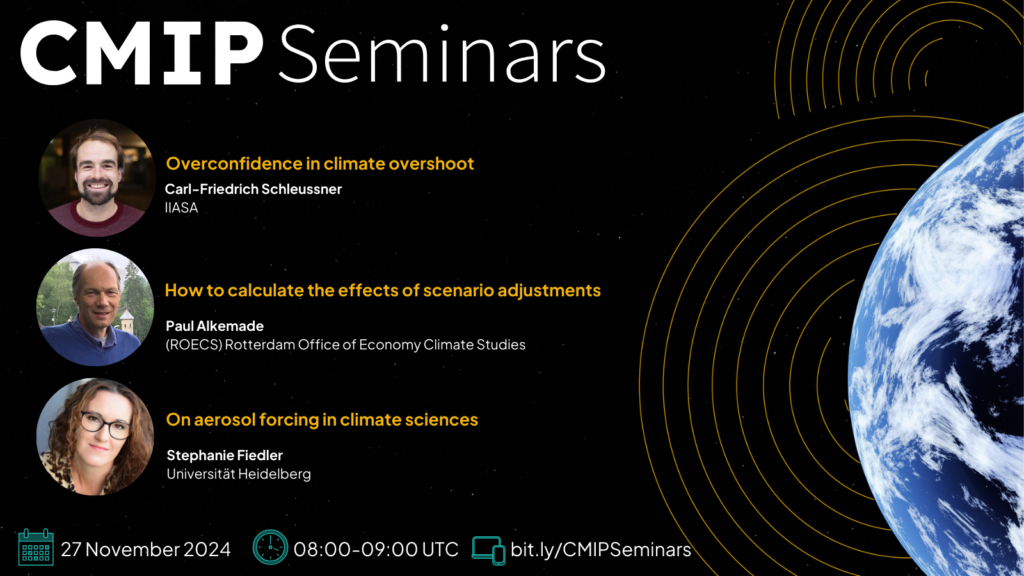
27 November, 2024 @ 08:00 – 09:00 UTC

Registration
Click the button below to register. We’ll send out information on how to attend the seminars to this list a few hours before the event starts. Note that, if you registered for a previous event, you are already registered for all future events.
Speakers

Carl-Friedrick Schleussner Senior Research Scholar, IIASA
Title: Overconfidence in climate overshoot
Abstract: This presentation examines overshoot pathways, addressing the implications of temporarily exceeding targeted warming limits before attempting temperature reduction. Our research reveals distinct climate change impacts in overshoot scenarios compared to those avoiding temperature exceedance, with potential long-term risk mitigation balanced against limited immediate relevance for adaptation planning. We highlight the geophysical need for substantial carbon dioxide removal capacity while acknowledging the technical, economic, and sustainability constraints that may hinder its large-scale deployment. Given the uncertainties in achieving temperature decline after overshoot within expected timescales, we emphasize that confidence in this approach remains low. Consequently, we argue that rapid near-term emission reductions remain the most effective strategy for mitigating climate risks.

Paul Alkemade Senior Researcher, (ROECS) Rotterdam Office of Economy Climate Studies
Title: How to calculate the effects of scenario adjustments
Abstract: Scenarios, such as the SSP, sketch possible global economic and social developments, including greenhouse gas emissions and climate change. Although scenarios are also quantitative, calculating marginal effects of specific scenario adjustments is not really feasible. For instance, what will be the costs and benefits in this scenario of accelerating decarbonization efforts in the coming 75 years by 1%, thus reaching the 2100 emission level 9 months (0.75 y) earlier?
In this presentation I show that one can calculate with a simple physical model plus a mathematical operation the effect on the atmospheric CO2 content of emission adjustments.
The physical model consists of an external source of CO2 in an atmosphere, connected to three effective sinks. The mathematical operation is a Laplace transform of the differential equations for the exchange of CO2. The (semi-)constant effective CO2 exchange rates between the atmosphere and the sinks are deduced from historical data plus MAGICC data for various SSP scenarios.
The new method is called Matrice and is valid for emission scenarios for which the expected surface temperature change in this century does not exceed 3 K. Since it is mathematically exact, Matrice provides not only marginal but also differential effects, e.g. it reproduces the differences in atmospheric CO2 content between various low- and moderate emission scenarios.
The main advantage of Matrice with respect to FAIR is, that it incorporates automatically saturation in CO2 uptake by sinks. The advantage with respect to MAGICC is, that it provides a quantitative algorithm –in the form of a (5×9) matrix– of the effects of small and medium-large adjustments in decarbonization schemes. Matrice can also be used in Integrated Assessment Models (IAMs) to calculate marginal and differential effects on the global temperature and on economic costs and benefits, also for other greenhouse gases.

Stephanie Fiedler Professor, Universität
Title: On aerosol forcing in climate sciences
Abstract: Climate forcing data is important for understanding and predicting Earth system changes. In addition to serving the need for forcing data in CMIP7 and its listed MIPs, the demand for forcing data is also increasing for other applications and has led to the desire to regularly update forcing data in a sustained mode for data delivery. Examples are forcing data for seasonal and decadal climate predictions, and experiments for explaining regional changes in the warming world.
As a provider of a CMIP7 forcing data set, I will first give insights on the current status of the update for the historical period 1850 to 2020. Specifically, I will talk about the data update for the simple plumes parameterisation (SPv2) in preparation for CMIP7. The parameterisation mimics the spatiotemporal development of anthropogenic aerosol optical properties and effects on clouds. While the parameterisation was originally designed for a single MIP endorsed by CMIP6, it has been implemented and used to induce aerosol effects on the simulated climate for multiple applications since. We will see results from the CMIP6 experiments that were carried out for the original purpose. The aim was here to better understand model diversity in aerosol radiative forcing. Moreover, I can share the first results from the updated SPv2 data based on new historical emissions as we move toward the CMIP7 forcing delivery by the CMIP climate forcing task team.
In the second part, I will talk about the need for forcing data from the perspective of a community MIP. In my role for AerChemMIP phase two, I will outline the plans for our CMIP7 fast-track experiments and the MIP’s new opportunities that arise from developments of the past few years. In so doing, we see again examples that stress the need for adequate climate forcing data. In AerChemMIP2, such data is essential to better understand the role of atmospheric chemistry and aerosols in climate change with a focus on short-lived climate forcers.
Interested in speaking at a seminar? Let us know by clicking the button below.
Recording
How to calculate the effects of scenario adjustments (Paul Alkemade, ROECS)
Overconfidence in climate overshoot (Carl-Friedrich Schleussner, IIASA)
